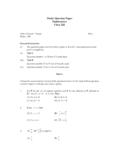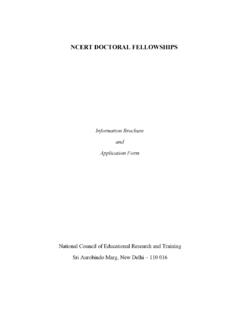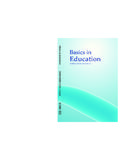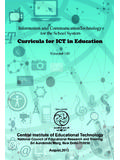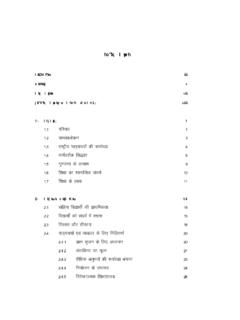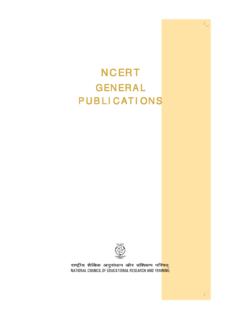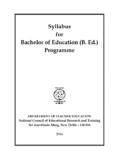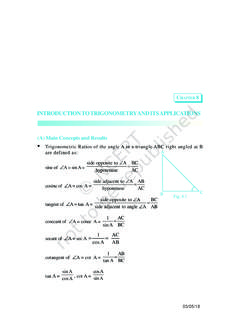Transcription of BIOLOGY (CLASSES XI –XII) - National Council of ...
1 BIOLOGY ( classes XI XII). In the present attempt of the NCERT to revise the BIOLOGY syllabus of the classes XI and XII, several documents like Learning without Burden', the National Curriculum Framework- 2005, the report of the National Focus Group on Teaching of Science' as well as reports of several external and internal reviews carried out, helped to decide the main focus of the revision. Hence, the revised syllabus aims primarily at reducing the information load while ensuring at the same time that ample opportunities and scope for learning and appreciating basic concepts of BIOLOGY continues to be available within the framework.
2 The BIOLOGY Syllabus reinforces the ideas introduced in the lower classes while the children learn new concepts besides getting an exposure to contemporary areas of BIOLOGY . This syllabus aims also at emphasising the underlying principles that are common to both animals and plants, as well as highlighting the interrelationships of BIOLOGY with other areas of knowledge. The format of the syllabus allows a simple, clear, sequential flow of concepts without any jarring jumps. The empirical experience gained and practical exercises carried out during the course would prepare the student to handle BIOLOGY easily at higher levels in case she/he opts to continue further studies in this area.
3 The revised syllabus stresses the connection of the study of BIOLOGY to real life problems -use of biological discoveries/innovations in everyday life - in environment, industry, medicine, health and agriculture. Since it was important that the quality of BIOLOGY education at the higher secondary level was not compromised in any way, the reduction in load from the syllabus required a very careful selection of topics to be taught. The Committee chose to leave topics out if: the question about why the child needs to study the topic at the particular stage could not be answered; if the topic had no direct relevance to the child was not contextual; if the content was repetitive across stages with no change in expected understanding, and if any topic was in isolation with no evident horizontal or vertical linkages.
4 The need for a network of ideas and cross-linking between the areas being identified was deemed very important. While deciding on the units/topics and the depth of each topic for the higher secondary level, a holistic view of the syllabus across all stages from the primary to the higher secondary and beyond was taken. Reducing the use of too many technical terms and avoiding very large numbers of examples will also help to make the content a little lighter. The importance of careful selection of illustrations and their use to make the concepts more explicit was stressed; in BIOLOGY the quality of illustrations can make or mar any attempt at good textbooks/.
5 Teaching. The principal objective at this stage would be to explore the variations amongst the living and developing respect for the diversities, and to appreciate that the most complex biological phenomena are also built on essentially simple processes. Learning BIOLOGY should uncover these elementary aspects and illustrate their linkage to more complex phenomena. It was also felt that the contributions of scientists (women scientists in particular) that led to critical and important discoveries in BIOLOGY should be highlighted, not merely through a chronological listing, but through brief biographical discussions, in an effort to bring out the processes that led to the discovery of principles and ideas in BIOLOGY .
6 These would stimulate critical and creative thinking. Besides, the proposed course at the higher secondary stage provides substantial orientation to the students to professional/career opportunities available in medicine, agriculture, research, teaching and industry. The syllabus also takes up issues pertaining to environment, health and other ethical issues that arise with any interference of human beings in the natural processes, which have great relevance from the societal 1. point of view. A discussion on these in the prescribed syllabus would help tackle prevalent misconceptions and empower the student to playa rational, responsible and informed role in society.
7 The teaching time in terms of number of periods available is indicated for each unit (total 180 periods). The young student would get an exposure to the various branches of BIOLOGY in a more contextual and friendly manner as they studied various units in the syllabus; each unit could also provide a glimpse of the career opportunities in the particular area. After studying any unit, the child gets an opportunity to think more deeply and to form informed opinions. The description of the diverse/various tools and techniques used in the study of BIOLOGY have not been collated to form a distinct unit in the syllabus. It is envisaged that the teachers who teach this syllabus and the textbooks prepared based on it, will discuss techniques in a contextual manner rather than distanced from real experimental situations.
8 The committee faced a dilemma while considering the topic of animal physiology: whether to deal with animal' or human' physiology. But the moment the focus of discussion shifted - from the subject' dictated one to the child - and the available time was considered, it was evident that human' physiology was more appropriate at this stage. The student is closest to herself and is curious about the functioning of the human body. The science' understood after a study of human physiology could be meaningfully applied to other organisms. The students should be encouraged to do at least one project, may be in Class XI. The basic objective of these projects should be to provide the child with an exposure to what it means to carry out an investigation, what research methodologies are, how data is analysed and presented and, how to interpret data and draw conclusions.
9 The project should provide space for the child to choose a theme in the area of her interest, think independently allow autonomous working and also provide freedom to present the project in any format of her/his choice, thus improving her/his communication skills. The syllabus committee hopes that the spirit of the exercise is carried forward to the textbook and the classrooms, across the country, ultimately meeting our objective of reducing the burden on the child while making learning BIOLOGY exciting. Teaching should emphasise on ways of acquiring knowledge rather than on conveying knowledge. 2. CLASS XI (THEORY). (Total Periods = 180).
10 I. Diversity in Living World ( Periods 25 ). What is living?; Biodiversity; Need for classification; Three domain of life; Taxonomy & Systematics;. Concept of species and taxonomical hierarchy; Binomial nomenclature; Tools for study of Taxonomy . Museums, Zoos, Herbaria, Botanical gardens. Five kingdom classification; Salient features and classification of Monera; Protista and Fungi into major groups; Lichens; Viruses and Viroids. Salient features and classification of plants into major groups- Algae, Bryophytes, Pteridophytes, Gymnosperm and Angiosperm (three to five salient and distinguishing features and at least two examples of each category); Angiosperms- classification up to class, characteristic features and examples.

